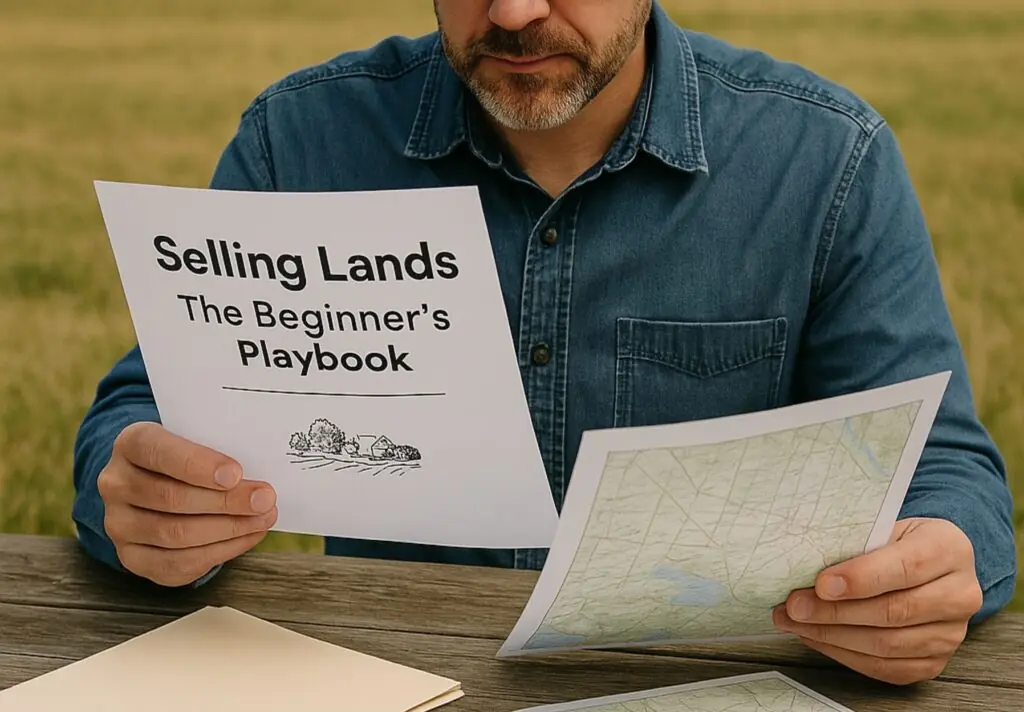Selling land can be a very different experience from selling a house. There’s no curb appeal to rely on, no open houses, and no fixed “market price” that works for every property. If you’re new to selling lands, the process can feel overwhelming — from figuring out the right price to finding qualified buyers. This beginner’s playbook is designed to guide you through each step, so you can confidently navigate the market, avoid common pitfalls, and walk away with the best deal possible in 2025.

Step 1 — Understand the Basics of Land Value
Before you can sell, you need to know what your land is worth.
Land value is based on:
- Location: Proximity to cities, highways, and amenities.
- Size and Shape: Usable acres and layout can impact desirability.
- Zoning: Determines whether the land can be used for residential, commercial, or agricultural purposes.
- Access & Utilities: Properties with water, electricity, and road access typically sell faster and for more.
💡 Pro Tip: Use online land sale platforms like LandWatch or Zillow to compare similar properties in your area.
Step 2 — Get the Paperwork Ready
Buyers want confidence that the sale will go smoothly.
Gather:
- Deed and title documents
- Survey maps
- Property tax records
- Any zoning or environmental reports
Step 3 — Boost the Land’s Appeal
First impressions matter — even for raw land.
- Clear debris and overgrown vegetation.
- Mark property boundaries with visible stakes or fencing.
- Provide drone or professional photos for online listings.
Step 4 — Price Your Land Competitively
Overpricing will scare buyers away.
- Look at comparable sales in your county.
- Consider hiring a licensed appraiser for accuracy.
- Factor in any upgrades or improvements you’ve made.
Step 5 — Market to the Right Audience
The buyer for farmland is different from the buyer for residential development.
- Farmland buyers value soil quality and water rights.
- Residential developers want land near growing cities.
- Investors look for appreciation potential.
List your property on:
- Online marketplaces (Land.com, Zillow, Craigslist)
- Local real estate offices
- Land auctions if you want a fast sale.
Step 6 — Negotiate Smartly
Expect offers to be below your asking price.
- Know your bottom line before negotiations begin.
- Don’t be afraid to counteroffer.
- Be prepared to offer owner financing to widen your buyer pool.
Step 7 — Close the Deal
Work with a title company or real estate attorney to ensure a clean transfer of ownership.
- Confirm all legal paperwork is complete.
- Verify payment before signing over the deed.
Common Beginner Mistakes to Avoid
- Selling without knowing the true value.
- Ignoring zoning restrictions.
- Not marketing the land properly.
- Accepting the first lowball offer.
- Failing to prepare proper legal documents.
Selling lands for the first time doesn’t have to be complicated. By understanding your property’s value, preparing it for sale, setting a competitive price, and marketing it strategically, you can make the process smoother and more profitable. With a little research, the right team, and patience during negotiations, you’ll be ready to close with confidence — and maybe even start planning your next investment. Consult our office if you plan to sell your property.